by Katrina A. Zavislan, Dr. David G. Holm, and Robin Young** (10/18)
Quick Facts
- Gardeners can grow many types of potatoes, including russet, red, and specialty potatoes, even in cool climates.
- Proper soil preparation, including soil testing, supports healthier plants and higher potato yield.
- Potatoes can be stored after harvest in a cool, dry place.
- The best defense against pest and disease problems is frequent monitoring for unusual changes or insects.
- Potatoes are naturally fat free and a good source of vitamin C.
- Colorado State University has released 22 new potatoes since 1975.
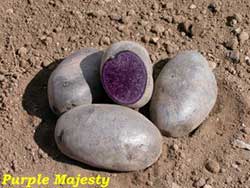 Purple majesty potatoes were developed by Colorado State University. Photo by David Holm. |
Potatoes are in interesting crop that can be successfully grown in Colorado home gardens. The potato, or Solanum tuberosum, is in the plant family Solanaceae. It is related to peppers, tomatoes, and eggplants, but is adapted to higher elevations and therefore harsher growing conditions. Native to the Andes region of South America, they were brought to Europe and later North America. Potatoes are a good source of vitamin C, potassium, vitamin B6, and fiber, and are naturally fat free.
Potatoes vary in shape, size, skin color, and flesh color. Some common types are russets, reds, whites, and specialties (including fingerling) potatoes. Gardeners should choose a variety based on the length of the growing season, disease pressure, garden size, and desired use. A few popular potatoes developed by Colorado State University include:
| Name | Type | Use | Maturity | Notes |
| Canela Russet | Russet | Baking | Medium | Long term storage potential |
| Colorado Rose | Red Skin | Boiling | Medium | Good red skin color retention |
| Mercury Russet | Russet | Baking, frying | Very early | Suitable for short growing seasons |
| Purple Majesty | Specialty | Roasting, sautéing | Early | Purple pigments are antioxidants |
| Red Luna | Specialty | Boiling | Medium | High yield |
| Yukon Gold* | Specialty | Boiling, roasting | Medium | Attractive yellow flesh |
*Yukon Gold is not a CSU variety, but is very popular with home gardeners
Getting Seed
Potatoes in the grocery store are typically treated with a sprout inhibitor and will not grow if planted in a garden. It is best to buy certified seed each spring that is inspected and within acceptable limits for diseases. Garden centers, reputable, garden catalogs, or your local CSU Extension Agent are all sources of certified seed.
Preparing Seed
Prior to seed preparation for planting, the potatoes should be kept between 50 and 65 Fahrenheit and away from direct sunlight for up to two weeks before planting to encourage germination and growth. However, in areas with short growing season, gardeners may use green sprouting to encourage early growth. To do this, arrange the potatoes in a single layer in a dry area exposed to light, such as a kitchen counter. When sprouts appear on part of the potato, turn it over to encourage even growth. The tubers should be planted before the sprouts reach one inch long.
Tubers, or part of potato tubers, are called seed pieces when they are planted in the soil. Each seed piece should have at least two eyes, as the stems will emerge from the eyes and grow into mature plants. If possible, plant small potatoes that are about one to two inches in diameter. These seed pieces do not need to be cut. The small tubers will not have a wound from cutting, and will therefore have no risk of disease transfer from a knife or of the cut site drying out. Potatoes smaller than 1 inch in diameter should not be used as seed, as they have limited stored nutrients available resulting in slower growth. Larger potatoes can be cut into two to three ounce pieces in preparation for planting. Best practices include:
- Cut blocky pieces, not long thin ones
- Make smooth, not jagged cuts. This reduces the risk of seed piece rot.
- Dip the cutting knife in a 10% bleach solution between potatoes. This prevents disease transmission from an infected potato to a healthy one.
Cut seed potato pieces can be planted immediately if the soil temperature is 55F or above. Alternately, the seed pieces can be kept in a dark humid room for four to seven days before planting. This will encourage a callus, or scar tissue to form, protecting the cut site from diseases in soil.
Soil Preparation and Fertilization
Gardeners should identify a spot in their garden with well-drained soil and no low spots where standing watering can pool to plant their garden. Potatoes grow best in sandy loam soil, but gardeners can manage a wide variety of soil types. Sandy soils can dry out quickly and may need more frequent watering. Soil that is high in clay can produce misshapen potatoes and should be tilled to break up large clumps prior to planting. Adding finished compost can provide organic matter and nutrients to the soil. However, both fresh manure and grass clippings can have weed seeds or too much salt. Additionally, manure may have been exposed to herbicides that can damage vegetable plants.
To apply the correct amount of fertilizer and manage the soil appropriately, gardeners should test their soil to determine pH, organic matter, and nitrogen levels. This can be done at the CSU Soil, Water, and Plant Testing Lab by bringing in a gallon size bag ¾ full of dry soil for testing.
Understanding the soil characteristics of a new garden space allows the gardener to select the appropriate type and amount of fertilizer. Potatoes grow best in a soil with a pH between 5.0 and 6.0. If a soil test is not available, gardeners can apply a fertilizer with a balanced ratio of nitrogen, phosphorous, and potassium (N:P:K) such as 10-10-10. Following is a typical fertilization strategy:
| Date | Rate | Application Method |
| Before planting | 1 lb. fertilizer per 10 row feet | Mix or rototill into top foot of soil |
| 1 week after emergence | .5 lb. fertilizer per 10 row feet | Band 2 inches away from the plant, water after fertilizing |
| 4 to 6 weeks after emergence | .5 lb. fertilizer per 10 row feet | Band 2 inches away from the plant, water after fertilizing |
It is important to rotate crop families about every three years to maintain healthy soil. If potatoes are planted in the same place for several years, pathogens can thrive in the soil and easily infect the next potato crop. Most pests and diseases can damage plants in the same botanical family, but cannot harm unrelated crops. The legume family, including beans and peas, is a good choice for crop rotation due to its ability to build nitrogen in the soil, while potatoes can deplete the soil nitrogen.
Planting
Potatoes can be planted up to two weeks before the last killing frost. The soil temperature should be at least 55F during the day and 45F at night. Cool, wet soil can delay sprout emergence or cause seed pieces to rot. Seed pieces should be planted about four inches deep, one foot apart, in rows that are about three feet apart. The sprouts or eyes should be planted facing up. Spacing can be adjusted based on the type of potato that is planted. Those with smaller size profiles, such as fingerling potatoes, can be planted closer together, about eight inches apart. However, potatoes planted too far apart can become misshapen or develop hollow heart.
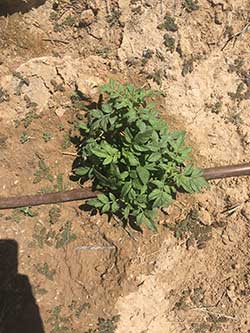 Some gardeners use drip irrigation systems, which slowly deliver water to the base of each plant. Photo by Trina Zavislan. |
Gardeners should add an additional two inches of soil around the top of the plant when they start to emerge from the soil. This is called hilling and ensures that the developing tubers are covered by soil and not exposed to sunlight. Mulching is beneficial and can prevent root damage, as roots can extend up to a foot from the base of the plant. Wood chips and straw are acceptable sources of mulch if they effectively block light. Checking frequently for exposed tubers and adding more soil or mulch will keep potatoes from being exposed to sunlight and turning green. Green potatoes should be discarded and not eaten.
Watering
Potatoes require consistent soil moisture. Variability such as infrequent or too heavy watering can cause growth cracks, irregular shapes, and hollow heart. Gardeners should determine the appropriate frequency and duration of watering based on the weather, soil type, and water needs of other plants in their garden. Potatoes typically require about two inches of water per week. A rain gauge placed at ground level near the potato plants will indicate how many inches of water the plants receive. The period of highest water need is in late June to early August when the potato foliage is fully developed. This is usually when the plant flowers and the leaves are dark green. As the plants begin to turn yellow and mature in the later summer, gardeners can water less to encourage tuber development and prevent potatoes from rotting.
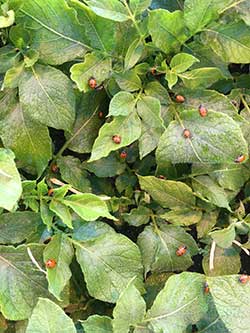 Gardeners may observe beneficial ladybugs on their potato plants. Photo by Trina Zavislan. |
Pests
It is important for gardeners to identify and control pests and diseases on their potato plants. This will improve yields, reduce waste, and protect the commercial potato industry in Colorado. Because most home gardeners plant potatoes on a small scale, it is not cost effective to purchase and apply pesticides. Instead, planting crop rotations with nitrogen fixers (legumes) and frequent visual inspection are key to maintaining plant health. If potatoes are grown every year, they should be grown in different areas of the garden each year. Some pests and disease only infect one type of vegetable, and planting it in the same area year after year creates a favorable environment for infection.
Weeds
Weeds should be identified and removed frequently, as they can act as hosts of potato disease and compete for water and nutrients. Weed control is especially important while the potato plants are less than a foot tall and fast growing weeds can outcompete the young potatoes. Most weeds thrive on disturbance to the soil and can even grow from fragmented root pieces, so it is best to pull them out by as much of the root as possible instead of cultivating them into the soil with a hoe or rake. This also prevents tuber and potato root damage.
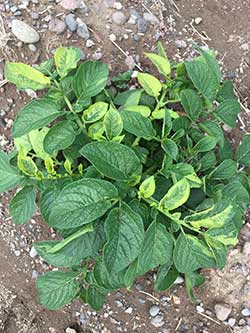 Gardeners should monitor their plants for unusual changes, such as this leaf color, which may indicate a disease. Photo by Trina Zavislan. |
Diseases
The best strategy to prevent potato diseases is to avoid conditions that favor disease development. This means maintaining soil moisture, checking regularly for unhealthy plants, and growing disease resistant varieties. Using certified seed prevents most soil borne diseases. Gardeners should check their potato plants regularly, and remove any that appear stunted, yellow, have shriveled leaves, or look different from the healthy potato plants. To avoid the spread of disease, these plants should be put in the garbage, not a compost pile. The most common potato disease gardeners encounter is powdery scab. Potatoes with this disease are still edible, but gardeners may choose to plant a variety more resistant to scab if it is a problem in their garden. Potatoes with red and yellow skin are more susceptible to scab than russet varieties. Rotating crops also helps interrupt the disease cycle and prevents nutrient depletion.
Insects
Frequent scouting for pests enables gardeners to identify and respond to insect problems before they become severe. Look on the underside of leaves, around the base of the plant, and other hard to see areas for insect eggs, larvae, and adults. A hand lens
may be helpful to see small insects. Removing juvenile insects reduces the population and prevents the development of a major pest problem. Pests can be removed by hand or using a high-pressure garden hose.
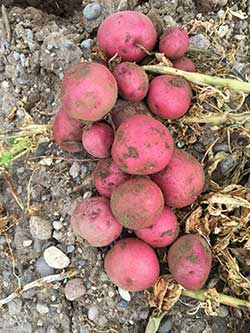 These potatoes are newly harvested. Photo by Trina Zavislan. |
Harvest
Indicators of mature potato plants include vine yellowing, vine death, and skin set, in which the potato skin does not peel off when rubbed. Immature or new potatoes harvested during the summer before the plant is mature should be eaten right away. These potatoes have a thin skin, bruise easily, and are not suitable for storage. Potatoes should be harvested before the first severe frost. If the potato plants are still green close to this time, the vines can be cut to about six inches tall one to two weeks before the desired harvest date. Decreased watering can also help the tubers mature and develop the skin. A fork or large shovel should be used to lift the plants out of the ground and prevent tuber damage. Gardeners can expect about two pounds of potatoes per plant, but this depends on the variety, weather, and pest, weed, and disease pressure.
Storage
After harvest, the potatoes should be stored in a dark place with high humidity at 50 to 60F for about two weeks to cure, or set the skin. This can occur in a cooler part of the house, such as a utility room with a portable humidifier. The potatoes are then ready for long term storage in the dark at 40F, which prevents the potatoes from sprouting or shriveling due to moisture loss. The tubers should not be kept in sealed containers, but should be stored in burlap bags or slotted bins conducive to airflow. If they will be eaten within a week, potatoes can be stored at room temperature.





